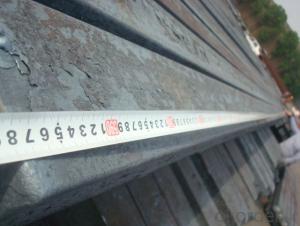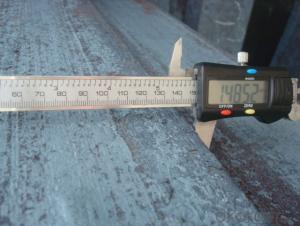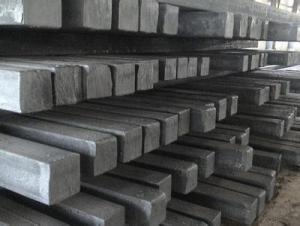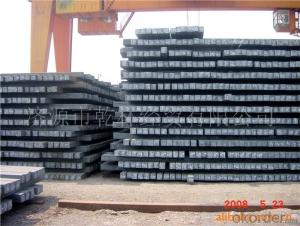Continue Casting Steel Billets/Blooms by Blasting Furnace
- Loading Port:
- Tianjin
- Payment Terms:
- TT OR LC
- Min Order Qty:
- 1000 m.t.
- Supply Capability:
- 100000 m.t./month
OKorder Service Pledge
OKorder Financial Service
You Might Also Like
Continue Casting Steel Billets/Blooms by Blasting Furnace
1.Structure of Continue Casting Steel Billets/Blooms by Blasting Furnace
Continue Casting Steel Billet by Blasting Furnace is the raw material of all kinds of steel mill. Billet section of square, round, flat, rectangular and abnormity, etc Several, mainly related to shape of rolled products. Simple rolled section steel, choose cross section of square billet or rectangular billet. rolling The sector products such as flat steel, Angle steel, select the rectangular billet or slab. Had better profiled billet when production beams, channels, and in rolling process Lines and improve the yield. The raw material of round billet is the production of seamless tube.
2.Main Features of Continue Casting Steel Billets/Blooms by Blasting Furnace.
Continue Casting Steel Billet by Blasting Furnace section size should meet the requirements of rolling deformation and finished product quality, but also roll strength and biting condition of restrictions. General steel Billet section height H. And the roll diameter D The ratio of the ( namely H/D) Should be less than or equal to zero 0.5 . Length of steel billet by finishing temperature, Rolling time and the length of the product Or times ruler. When heated too long accident prone to bump the furnace wall of steel, too short, furnace bottom utilization rate is not high, influence the heating furnace production. For the production Choose a variety of steel and steel billet, should consider the affinities of billet, as far as possible in order to improve the productivity of the roughing mill, simplify the stock management of workshop.
There are three shapes of the steel billets: square billet, slab, rectangular billet The Chinese billet, rectangular billet is mainly suitable for rolling hot rolled strip, building reinforced bar, Ordinary wire, high speed wire rod and various small profile. Of the slab are mainly used for rolling plate and hot coil sheet.
3. Continue Casting Steel Billets/Blooms by Blasting Furnace Images


4. Continue Casting Steel Billets/Blooms by Blasting Furnace Specification
Continue Casting Steel Billet by Blasting Furnace rolled steel, after processing can be used for mechanical parts, forging parts, processing all kinds of steel, steel Q345B channel steel, wire rod is the role of the billet. Steel billet is used in the production of semi-finished products, generally cannot be used directly for the society. Steel billets and steel are strictly divided into standard, cannot decide to whether the business enterprise of the final product, and according to unified standards to perform the whole society. Typically, billet and the steel is relatively easy to distinguish, but for some steel billet, and have the same specification and same steel purposes (such as rolling tube billet), whether can be used for other industries, whether through steel processing process, whether through a finished product rolling mill processing to distinguish
Material standard The editor Range of thickness: 150-240 - mm + / - 5 mm width range: 880-1530 - mm + / - 20 mm Length: 3700-10000 - mm + / - 500 - mm Cross-sectional size: 64 * 64; 82 * 82; 98 * 98; 124 * 124; 120 * 150; 152 * 164; 152 * 170 mm Length: 9000 mm Section of tolerance: billet: 1.0 + / - 2.0-1.0 + / - 1.0 mm slab: width: + / - 2.0 mm thickness: + / - 3.0 mm The length tolerance: + / - 200 mm Section diagonal tolerance: 3.5-8.0 MM Billet section size protrusions requirements: < 1242 mm, do not allow; > = 1242 mm, < = 2 mm 1242 mm, < = 3 mm Beheading (shear) extension deformation: < 1242 mm billet: no control; The slab: < = 15 mm Surface tilt: no more than billet section 0.1 Bending: every 1 m length is not more than 10 mm The distortion: length < = 5 m, < = 11. ; The length of the < = 7.5 M, < = 5. Material % 3 sp/PS chemical composition: C Mn Si S P
5.FAQ of Continue Casting Steel Billets/Blooms by Blasting Furnace
We have organized several common questions for our clients,may help you sincerely:
①How about your company?
A world class manufacturer & supplier of castings forging in carbon steel and alloy steel,is one of the large-scale professional investment casting production bases in China,consisting of both casting foundry forging and machining factory. Annually more than 8000 tons Precision casting and forging parts are exported to markets in Europe,America and Japan. OEM casting and forging service available according to customer’s requirements.
②How to guarantee the quality of the products?
We have established the international advanced quality management system,every link from raw material to final product we have strict quality test;We resolutely put an end to unqualified products flowing into the market. At the same time, we will provide necessary follow-up service assurance.
③Could I know the process of the producing?
Sure.Steel billet is produced by the method of through three processes: It is through the steelmaking system of continuous casting equipment, directly by the molten steel pouring into billet; The second is the steelmaking system in the production of steel ingot casting billet through system of steel rolling rolling equipment or processing of steel semi-finished products; Three is the steelmaking system production of steel ingot by forging the semi-finished product processing equipment.
- Q: What are the different types of forging processes used for shaping steel billets?
- There are several types of forging processes used for shaping steel billets. Some common ones include open-die forging, closed-die forging, impression-die forging, and seamless rolled ring forging. Each process has its unique characteristics and is suitable for specific applications.
- Q: How are steel billets used in the production of conveyor systems?
- Steel billets are an essential component in the production of conveyor systems as they are used to create the main structural framework. The billets are first heated and then passed through a series of rollers to shape them into the desired form of the conveyor system. This process, known as hot rolling, ensures that the steel billets are transformed into long, slender bars with a consistent cross-sectional shape. Once the steel billets have been shaped, they are further processed to create various components of the conveyor system. These components include conveyor frames, support beams, brackets, and other structural elements that provide stability and strength to the overall system. Steel billets are well-suited for this purpose due to their high tensile strength and durability. In addition to the structural components, steel billets are also used to produce conveyor rollers. These rollers are crucial for facilitating the movement of materials along the conveyor system. The steel billets are machined and formed into cylindrical shapes, which are then fitted with bearings to ensure smooth rotation. The rollers are then installed at regular intervals along the conveyor, allowing for efficient and continuous material handling. Moreover, steel billets are often used to manufacture conveyor belts. The billets are processed into thin sheets, which are then coated with various materials such as rubber or fabric to provide grip and durability. These belts are responsible for carrying the load of the materials being transported and are designed to withstand heavy usage and harsh environments. Overall, steel billets play a vital role in the production of conveyor systems by providing the necessary structural support, as well as components like rollers and belts. Their strength, durability, and versatility make them an ideal choice for constructing conveyor systems that can handle heavy loads and ensure efficient material handling in various industries.
- Q: What are the main safety considerations when handling steel billets?
- The main safety considerations when handling steel billets include wearing appropriate personal protective equipment such as gloves, safety glasses, and steel-toed boots to protect against potential injuries. Proper lifting techniques should be used to prevent strains and back injuries when moving heavy billets. Additionally, ensuring a well-organized and clutter-free work area, as well as proper storage and stacking of the billets, can help prevent accidents and injuries.
- Q: What is the process of heat treatment for steel billets?
- To alter the mechanical properties of steel billets, they undergo a process called heat treatment. This process is essential for increasing the steel's hardness, strength, and toughness, making it suitable for various industrial applications. The heat treatment process begins by subjecting the steel billets to controlled heating and cooling cycles. The heating stage involves raising the billets' temperature to a specific range, typically above the steel's critical point. This allows for the transformation of the steel's microstructure. Various methods, such as electric furnaces, gas furnaces, or induction heating, can be used for heating. Once the desired temperature is reached, the billets are held at that temperature for a specified period. This stage, known as soaking or holding, ensures that the heat distribution is uniform throughout the billet and allows for the homogenization of the microstructure. After the soaking stage, the billets undergo controlled cooling, which is equally important as the heating stage. The cooling rate is carefully controlled to achieve the desired properties. Cooling methods such as air cooling, oil quenching, or water quenching can be used. Each method provides different cooling rates and results in different material properties. During the cooling stage, the steel undergoes a phase transformation, resulting in the formation of different microstructures. For instance, rapid cooling through water quenching leads to the formation of martensite, a hard and brittle microstructure, while slower cooling can produce pearlite, a softer and ductile microstructure. After cooling, additional processes such as tempering or annealing may be applied to the steel billets. Tempering involves reheating the steel to a specific temperature and holding it there for a certain period, followed by controlled cooling. This process reduces brittleness and improves toughness and ductility. Annealing is another heat treatment process that involves heating the steel to a specific temperature and slowly cooling it. This process relieves internal stresses, refines the grain structure, and enhances the machinability of the steel. Overall, the heat treatment process for steel billets involves carefully controlled heating, soaking, cooling, and sometimes additional processes to achieve the desired mechanical properties. This process is crucial for enhancing the performance and durability of steel billets, making them suitable for various industrial applications such as construction, automotive, and machinery.
- Q: What is the chemical composition of a typical steel billet?
- A typical steel billet, which is a semi-finished product used in the production of various steel products, is primarily composed of iron and carbon. The specific chemical composition can vary depending on the grade and intended application of the steel billet. In addition to iron and carbon, other elements such as manganese, silicon, sulfur, and phosphorus may be present in varying amounts. These elements are added to impart specific properties to the steel, such as increased strength, improved machinability, or enhanced corrosion resistance. The exact composition of a steel billet is carefully controlled during the manufacturing process to ensure the desired mechanical and chemical properties are achieved.
- Q: What is the role of steel billets in the construction of railway stations?
- Steel billets play a crucial role in the construction of railway stations. These billets are essentially semi-finished steel products, typically in a rectangular or square shape, that are used as raw material for various construction purposes. In the context of railway stations, steel billets are primarily used in the fabrication of structural components such as beams, columns, and trusses. These components provide the necessary strength and stability to support the weight of the station building, platforms, and any other structures associated with the station. One of the main advantages of using steel billets in railway station construction is their high strength-to-weight ratio. Steel is known for its exceptional strength, making it an ideal material for supporting heavy loads. By using steel billets, engineers can design and construct railway stations that can withstand the constant traffic and heavy footfall experienced in these public spaces. Additionally, steel billets offer excellent durability, corrosion resistance, and fire resistance, all of which are essential factors in ensuring the long-term safety and structural integrity of railway stations. These properties make steel billets a reliable and cost-effective choice for construction projects where safety and longevity are of utmost importance. Furthermore, steel billets can be easily shaped and fabricated into various sizes and dimensions, allowing for flexibility in design and construction. This versatility enables architects and engineers to create aesthetically appealing and functional railway station structures that meet the specific requirements of the project. Overall, the role of steel billets in the construction of railway stations is to provide the necessary strength, durability, and versatility required for the structural components that support these vital transportation hubs. By using steel billets, railway station construction projects can be completed efficiently, ensuring the safety and comfort of passengers for years to come.
- Q: Can steel billets be used for making jewelry?
- Steel billets can technically be used for making jewelry, but it is not a common or preferred material for this purpose. Steel is primarily used in industries such as construction and manufacturing due to its strength and durability. Jewelry, on the other hand, often requires materials that are visually appealing, malleable, and hypoallergenic. Steel is not typically considered visually attractive for fine jewelry, as it lacks the luster and shine that precious metals like gold or silver possess. Additionally, steel is not as malleable as other metals commonly used in jewelry making, making it difficult to shape intricate designs or delicate details. Lastly, steel may not be hypoallergenic, meaning that some individuals may have allergic reactions or skin irritations when wearing jewelry made from steel. Overall, while steel billets can technically be used for making jewelry, it is not the most suitable or preferred material for this purpose.
- Q: What are the potential risks associated with steel billet production?
- There are several potential risks associated with steel billet production. One significant risk is the high temperature involved in the process, which can lead to burns and fire hazards if not properly managed. Additionally, the handling of heavy machinery and equipment poses a risk of accidents and injuries to workers. The use of chemicals and hazardous substances in the production process can also pose health risks if not handled safely. Another potential risk is the emission of pollutants and greenhouse gases during production, contributing to environmental concerns. It is crucial for steel billet producers to implement appropriate safety measures, train their employees, and adhere to environmental regulations to mitigate these risks.
- Q: What is the typical fatigue strength of a steel billet?
- The fatigue strength of a steel billet can vary based on factors like its specific steel composition, manufacturing process, and surface treatments utilized. Fatigue strength generally refers to a material's ability to endure repeated loading and unloading cycles without breaking. Compared to other materials, steel typically possesses high fatigue strength due to its strength and durability. However, the precise fatigue strength value can differ considerably depending on the steel grade and intended use. In engineering and industry, fatigue strength is often represented by a stress-life (S-N) curve. This curve depicts the stress level exerted on the steel billet versus the number of cycles required for failure. The curve's shape offers valuable insights into the steel's fatigue behavior. It is crucial to note that determining the fatigue strength of a steel billet usually involves rigorous testing procedures. Fatigue testing machines are employed to subject the material to cyclic loading until failure occurs. These tests assist engineers and manufacturers in establishing safe operating limits for various steel grades and applications. Consequently, without specific details regarding the steel grade, manufacturing process, and other factors, it is not feasible to provide an exact value for the typical fatigue strength of a steel billet. Nevertheless, it is widely acknowledged that steel possesses excellent fatigue resistance and can withstand a significant number of cycles before failure, rendering it a dependable choice for numerous structural and mechanical applications.
- Q: What is billet?
- Mould blank and continuous casting billet: mould blank and continuous casting billet,
Send your message to us
Continue Casting Steel Billets/Blooms by Blasting Furnace
- Loading Port:
- Tianjin
- Payment Terms:
- TT OR LC
- Min Order Qty:
- 1000 m.t.
- Supply Capability:
- 100000 m.t./month
OKorder Service Pledge
OKorder Financial Service
Similar products
Hot products
Hot Searches
Related keywords


























